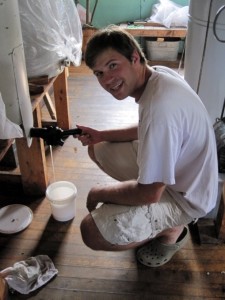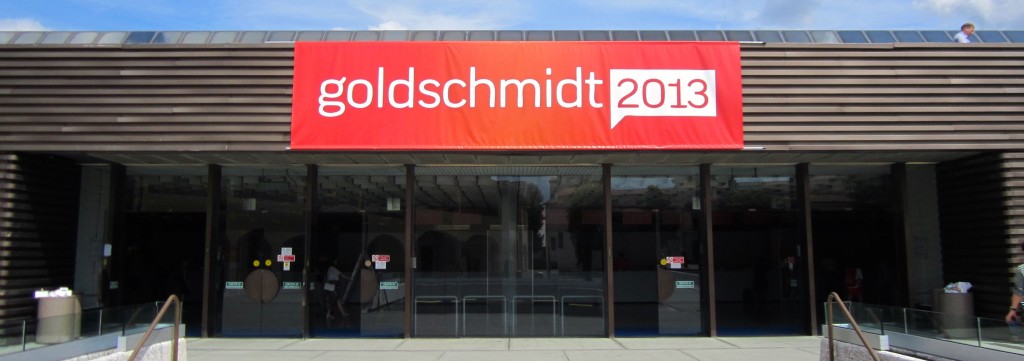
Goldschmidt 2013 revisited
The Goldschmidt blogging team have all had time to travel back to their homes, some even moving to a new country! We’ve put together our highlights from the conference, see them below. Feel free to add your own personal highlights in the comment section at the bottom. Enjoy!

Though Goldschmidt2013 happened not even 3 weeks ago, it seems more like 2 months for me. Last week I spent in my home country, the Netherlands. Then I moved to Southern California and started a postdoc at JPL this week. Busy and exciting times!
Thinking back, two things really stood out for me at Goldschmidt. The first was meeting a “famous” colleague, who was very interested in collaborating on some of my samples. This is always the best about conferences I think, meeting new people, catching up with old friends, and talking about science. I’m always full of new ideas and motivations after such a week. The second was convening a session for the first time. We did our best to invite a diverse range of speakers, and I think it turned out a very interesting session.
Emma.
There were so many highlights to this year’s meeting in Florence I have struggled to distil them to a workable number. Therefore I have selected my 3 favourite quotes from notes I made during Goldschmidt2013. In chronological order:
“Taking one river sample per month is like listening to Beethoven’s symphonies one note per minute” Jérôme Gaillardet
I mentioned this quote in another post during the week. It was taken from a presentation as part of the Critical Zone Observatory Open Forum Meeting on Monday evening. Jérôme was outlining the importance of holistic studies with thorough sampling to understand Critical Zone processes.
“Let’s skip all the details and go straight to the conclusions. That’s usually how I read a paper” Philippe Van Cappellen
Philippe, in his second keynote talk of the day (I know!), wanted to make sure the session got to the important aspects of several studies from his group. With a talk title of “Where Groundwater Meets Surface Water” there obviously needed to be a wide range of results presented to give a clear picture of this complicated environment. Philippe’s whistle-stop approach enabled him to get through a whole load of important processes, with clarity and without getting bogged down, refreshing!
“Icebergs are mobile MacDonald’s for phytoplankton in the Southern Ocean” Martyn Tranter
Also from a session’s keynote talk, this excellent turn of phrase evokes a mental image which has made Martyn’s Thursday afternoon talk stick with me for 2 weeks.
Along with the numerous Goldschmidt highlights there were areas for improvement… the main one, of course, was that we didn’t get Morgan Jones’ #OverlyHonestTalks theme running. This would be a trend on twitter where researchers present their results without the hype, for example:
“When two waters are mixed in different proportions, the stable isotopes of water form a line” @snowandscience
“The chemistry of a glacial river changes when the glacier melts” @drmorganjones
“Added acid to a solution and the pH went down…” @brayaw
Maybe next year…
Andy.
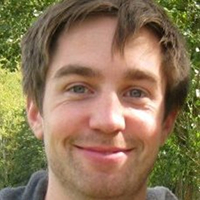
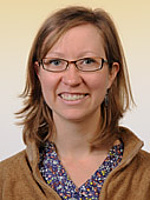
Once again, Goldschmidt flew by and two weeks later I still find myself thinking, “Darn! I missed that [talk, poster, person].” Oh, well. You can only do so much with 1 week, 4100 people and 19 simultaneous sessions. Nevertheless, there are some experiences that stand out when I look back on the whirlwind week in Florence:
Presenting in an all-female session on Monday (19e: Phototrophic life and Earth’s redox evolution) was a huge highlight. The session was organized by Jenn Macalady and Trinity Hamilton from Penn State and covered biomarker synthesis, stable isotopic signatures and redox cycling (Fe, S and Mn) mediated by phototrophs in analogue sites, laboratory experiments and geological samples. To see good science and representation by woman in this session was a welcome contrast to the predominantly male recipients of awards at Goldschmidt 2013, already mentioned by Emma Versteegh in her post on August 27.
Making connections with other scientists is always one of my favorite parts about Goldschmidt. One person I enjoyed meeting this year was Prof. Bill Gilhooly from Indiana University-Purdue University, Indianapolis (IUPUI). Bill gave an invited talk in session 3g (Reconstructing Ancient Surface Environments from Modern (Near) Analogues) on Friday about “ground-truthing” the multiple sulfur isotope signatures that are used to reconstruct past redox conditions based on his work in modern sulfidic sediments. We compared notes over dinner with a group one night about the complementarity between his work on sulfidic conditions and mine that is focused on ferruginous conditions. And of course “small world” syndrome set in after realizing my sister-in-law is a graduate student in his department.
Finally, I always appreciate the diversity of sessions at Goldschmidt and that it gives me exposure to research areas a bit removed from my own, or just new to me. This year I spent a lot of time in sessions that dealt with trace element distribution in sediments, seawater and marine biota, and Ocean Anoxic Events (OAE) (e.g. theme 17: Oceans and Atmospheres). It was great fun to observe what the hot topics are in these areas, but I did encounter some limits to my own knowledge: I’m still looking for someone to explain to me what is meant by the term “leaky bucket”!
Betsy.
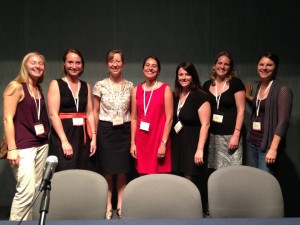
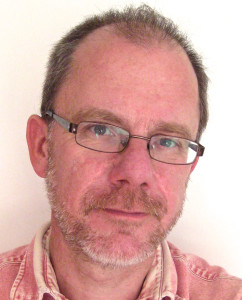
Goldschmidt2013? I am already thinking of 2014! But casting my mind back, it was a great meeting. Despite getting lost too many times among the lecture rooms in the basement, like some sort of minimalist maze where you never quite know which direction you are walking, it was a conference centre design like no other. If I felt in need of a workout, I simply took the long way round … walking from floor to floor via the never-ending external ramps.
As for Science … I enjoyed some great discussions over the poster sessions, sat through talks on planetary evolution in the early Solar System that blew my mind (without really working out how credible they were), and really appreciated the quality of so many of the presentations, especially from the grad students from our Department! It was a pleasure giving the citation for a colleague’s medal, meeting old friends in the beer queue and sampling some of the excellent food on offer in Florence. What a great city for a conference. I’m looking forward to future Goldschmidts, and must get back into the lab to collect the next dataset in preparation.
Simon
Goldschmidt2013 can be described by a few words: whirlwind, tiring, stimulating and most of all amazing. This was my second Goldschmidt conference and my first as a blogger. Actually, it was the first conference I have ever blogged and I have to say it made for a different feel. At conferences I have mostly gone to talks that apply to my own field in some way and thought about the science as it applies to my work. However, this time I had to look at talks through a second lens: that of a blogger/journalist. For the first time I was trying to think about more than just myself and my own work when viewing talks and posters. At this Goldschmidt I was trying to think about how the work of others could be distilled into a blog post, or how their work could interest readers. It made for a very new and interesting experience and I think it helped me get more value out of attending a conference than I have ever experienced before.
The highlights for me were numerous. Firstly, I loved giving my own talk! It was fun to get up in front of my peers and discuss the work that I and others in my lab have been doing on Fukushima iodine. I also enjoyed the other talks in my session and came away with lots of great ideas and possible collaborations. The second highlight was the Impacts of Geochemistry session. This session was tailor made for blogging and a lot of the talks were fascinating. The talk by John Ludden on the Geochemistry of London was very interesting, as was the talk by my old Prof Kurt Kyser on Geochemical Tools for finding Ore Deposits. The third highlight was the personal interactions. For example, meeting the other bloggers was great. We all were there for the same reason and it was great to interact on personal level as opposed to digital.
Here’s looking forward to next year in Sacramento!
Matt
